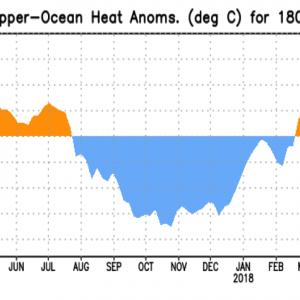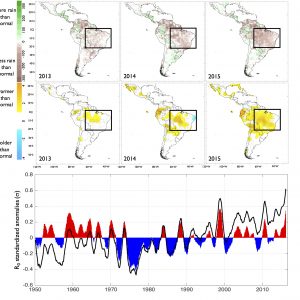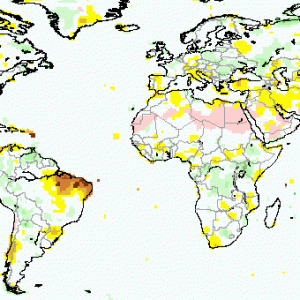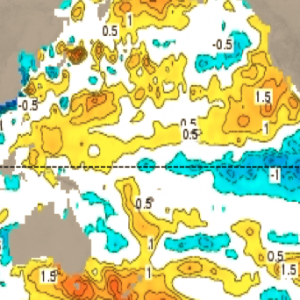Results for 'forecasts'
Found 528 results.
2018 May Quick Look
In mid-May 2018, the east-central tropical Pacific waters reflected ENSO-neutral conditions. Most key atmospheric variables also indicated neutral conditions, although the upper level wind anomalies show remnants of La Niña. The subsurface water temperature continued to be above-average. The official CPC/IRI outlook calls for neutral conditions through the September-Novemeber season, with a nearly 50% chance of El Niño development by year’s end. The latest forecasts of statistical and dynamical models collectively favor weak El Niño development by year’s end, but forecasters hedge on this due to low confidence at this time of year.

April Climate Briefing: La Niña Transitions Out, Neutral Next
Read our ENSO Essentials & Impacts pages for more about El Niño and La Niña. Tony Barnston provides an overview of the briefing What’s New Sea-surface temperature (SST) anomalies in the equatorial Pacific Ocean have continued to warm since last month’s briefing, crossing from La Niña to neutral territory over the last few weeks. Weekly SST anomalies in the area of […]
Simon Mason Wins WMO Award for Outstanding Service
The World Meteorological Organization’s Commission on Climatology (CCL) honored Simon Mason, IRI’s chief climate scientist, with its 2018 Award for Outstanding Service. The award was presented in Geneva on April 10 by Thomas C. Peterson, the outgoing President of CCL. In a letter, Elena Manaenkova, the Deputy Secretary-General of WMO, wrote the award was, “in […]
2018 April Quick Look
In mid-April 2018, the east-central tropical Pacific waters were at warm-neutral to borderline La Niña levels, while many key atmospheric variables continued to indicate weak La Niña. Importantly, the east Pacific subsurface water temperature has become moderately above average. The official CPC/IRI outlook calls for a transition from La Niña to neutral conditions during the March-May season, with a further warming tendency later in the year. The latest forecasts of statistical and dynamical models support this scenario.
20170605
The IRAP Caribbean team conducted 6 training events for ~9 communities. There were a total of 195 participants. Five groups provided key contribution to both context and logistics: IRAP, IICA, CIB, UWI, and MSJ. The objectives of these workshops were: (1) develop an understanding of the available climate information tools and (2) co-develop an understanding of the connection between […]

Partnership for a Resilient and Secure Food System in Vietnam
This is an an abbreviated version of a piece originally posted on the website of a partner organization, the CGIAR Research Program on Climate Change, Agriculture and Food Security (CCAFS). Read the full piece here. With a coastline spanning 3,260 kilometers, Vietnam is highly vulnerable to the impacts of climate change, such as sea level rise, […]

World Meteorological Day 2018: Zika Update
In conjunction with World Meteorological Day, the World Meteorological Organization has released its “State of the Climate Global 2017” report. It was a record-setting year in terms of the costs of extreme events, which included the hurricanes in the North Atlantic, monsoon flooding on the Indian subcontinent and drought in parts of eastern Africa. The […]

March Climate Briefing: Last Gasp of La Niña Influence
Read our ENSO Essentials & Impacts pages for more about El Niño and La Niña. What’s New Sea-surface temperature (SST) anomalies in the equatorial Pacific Ocean are trending warmer since last month’s briefing, but they remain in the La Niña realm. Weekly SST anomalies in the area of the Pacific that helps define El Niño and La Niña events, called […]
2018 March Quick Look
In mid-March 2018, the east-central tropical Pacific still reflected weak La Niña conditions. Most of the key atmospheric variables, however, no longer show patterns suggestive of La Niña, and the east Pacific subsurface water temperature has warmed back to average. The official CPC/IRI outlook calls for a transition from La Niña to neutral conditions during the March-May season. The latest forecasts of statistical and dynamical models support this scenario.

February Climate Briefing: La Niña Pattern Holds
Read our ENSO Essentials & Impacts pages for more about El Niño and La Niña. Tony Barnston provides an overview of the briefing What’s New Since last month’s briefing, sea-surface temperature (SST) anomalies have cooled slightly in the area of the central equatorial Pacific Ocean that helps define El Niño and La Niña events, called the Nino3.4 region (see first map below). The […]

You must be logged in to post a comment.